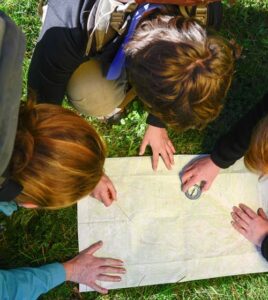
The theme of navigation appears regularly in our lives at True North. A student’s arrival is typically discussed as “the beginning of the journey” through True North. As a therapist, I speak with students and parents about “shifting course,” or “finding a new path.” One often arrives to a program like True North after they “took a wrong turn,” “started moving in the wrong direction,” or “got lost.” We move through life, we choose paths, and we are met with consequences.

When a student begins to take on leadership responsibilities at True North, they will at some point be assigned to be the ‘hike leader’ for a week. It is their responsibility not only to keep the group moving as an efficient, safe, and effective rate, but also to facilitate the actual navigation over ridges, through swamps, and to their evening camping spot, often miles from their point of origination. Lacking trails, signs, or any other indicators, the student navigator is forced to rely on just 2 tools: a map and a compass. However, before one can finding a bearing (direction to follow), they must first use the compass to adjust the map so that it aligns with the real world (the map’s north pointing the actual north pole, south to south, etc). A crucial complication arises at this point: a compass’s magnetic arrow does NOT align exactly with the north pole. In Vermont, it’s roughly 15 degrees off, since it points toward the most powerful point in Earth’s electro-magnetic field. This means that the navigator must make an adjustment from the direction the compass initially tells them, which is known as magnetic north, and shift their orientation to find True North.
Obviously, the metaphors here run deep. We believe that our students want to move forward, and to reach healthy destinations in their lives, but they have lacked the tools to do so. We do not believe that our students have a desire to create problems or to hurt their relationships. Instead, we look at our students as young people who genuinely want to do well, who have worked hard to find a sense of connection and belonging, and at some point, got off course. With every morning map orientation and plan, we offer our students a moment of direct metaphorical reflection: here’s the easy way to go, which we know doesn’t arrive at our intended destination. You’ve tried that before and you know how it ends. Instead, let’s use a new tool and skill to make an adjustment, find True North, and start to move forward, navigating the inevitable complications ahead of you with hope and confidence in your ability to arrive safely.


